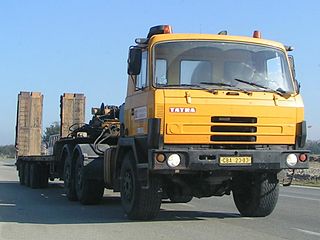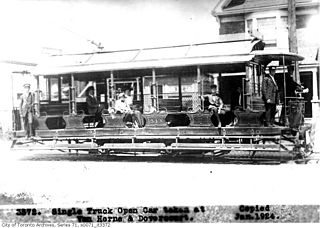
A truck or lorry is a motor vehicle designed to transport cargo, carry specialized payloads, or perform other utilitarian work. Trucks vary greatly in size, power, and configuration, but the vast majority feature body-on-frame construction, with a cabin that is independent of the payload portion of the vehicle. Smaller varieties may be mechanically similar to some automobiles. Commercial trucks can be very large and powerful and may be configured to be mounted with specialized equipment, such as in the case of refuse trucks, fire trucks, concrete mixers, and suction excavators. In American English, a commercial vehicle without a trailer or other articulation is formally a "straight truck" while one designed specifically to pull a trailer is not a truck but a "tractor".

A pickup truck or pickup is a light-duty truck that has an enclosed cabin and an open cargo area with low sides and tailgate. In Australia and New Zealand, both pickups and coupé utilities are called utes, short for utility vehicle. In South Africa, people of all language groups use the term bakkie, a diminutive of bak, Afrikaans for "bowl" or "container".

Line 3 Scarborough is a light rapid transit line that is part of the Toronto subway system in Toronto, Ontario, Canada. The line runs entirely within the suburban district of Scarborough, encompassing six stations and 6.4 kilometres (4.0 mi) of mostly elevated track. It connects with Line 2 Bloor–Danforth at its southwestern terminus, Kennedy, and terminates in the northeast at McCowan.

A railroad car, railcar, railway wagon, railway carriage, railway truck, railwagon, railcarriage or railtruck, also called a train car, train wagon, train carriage or train truck, is a vehicle used for the carrying of cargo or passengers on a rail transport system. Such cars, when coupled together and hauled by one or more locomotives, form a train. Alternatively, some passenger cars are self-propelled in which case they may be either single railcars or make up multiple units.

Innovia Metro is an automated rapid transit system manufactured by Bombardier Transportation. Innovia Metro systems run on conventional metal rails and pull power from a third rail, but are powered by a linear induction motor that provides traction by pulling on a "fourth rail" placed between the running rails. A new version of the technology being marketed by Bombardier is compatible with standard electric rotary propulsion.

Heavy equipment or heavy machinery refers to heavy-duty vehicles, specially designed for executing construction tasks, most frequently ones involving earthwork operations or other large construction tasks. Heavy equipment usually comprises five equipment systems: implementation, traction, structure, power train, control and information.

The Tatra 815 is a truck family, produced by Czech company Tatra. It uses the traditional tatra concept of rigid backbone tube and swinging half-axles giving independent suspension. The vehicles are available in 4x4, 6x6, 8x8, 10x8, 10x10, 12x8 and 12x12 variants. There are both air-cooled and liquid-cooled engines available with power ranging from 230–440 kilowatts (310–590 hp). As a successor to Tatra 813 it was originally designed for extreme off-road conditions, while nowadays there are also variants designated for mixed use.

The Toronto Railway Company (TRC) was the operator of the streetcar system in Toronto between 1891 and 1921. It electrified the horsecar system it inherited from the Toronto Street Railway, the previous operator of streetcar service in Toronto. The TRC was also a manufacturer of streetcars and rail work vehicles, a few of which were built for other streetcar and radial operators.

The Urban Transportation Development Corporation Ltd. (UTDC) was a Crown corporation owned by the Government of Ontario, Canada. It was established in the 1970s as a way to enter what was then expected to be a burgeoning market in advanced light rail mass transit systems. UTDC built a respected team of engineers and project managers. It developed significant expertise in linear propulsion, steerable trucks and driverless system controls which were integrated into a transit system known as the Intermediate Capacity Transit System (ICTS). It was designed to provide service at rider levels between a traditional subway on the upper end and buses and streetcars on the lower, filling a niche aimed at suburbs that were otherwise expensive to service.
A Buffer stop, bumper, bumping post, bumper block or stopblock (US), is a device to prevent railway vehicles from going past the end of a physical section of track.

The Siemens S700, its predecessor the S70 and European variant, the Avanto are a series of low-floor light-rail vehicles (LRV) and streetcars manufactured by Siemens Mobility, a division of German conglomerate Siemens AG.

Nippon Sharyo, Ltd. , formed in 1896, is a major rolling stock manufacturer based in Nagoya, Japan. In 1996, it abbreviated its name to "日本車両" Nippon Sharyō. Its shortest abbreviation is Nissha "日車". It was a listed company on Nikkei 225 until 2004. It is listed on the Tokyo Stock Exchange and Nagoya Stock Exchange as ticker 7102. In 2008, Central Japan Railway Company became the majority shareholder (50.1%) of the financially struggling Nippon Sharyo making the firm a "consolidated subsidiary" of JR Central. In July 2012 Nippon Sharyo USA started production in their new facility in Rochelle, Illinois. The facility closed at the end of October 2018 due to a lack of orders.
A work train or departmental train is one or more rail cars intended for internal non-revenue use by the railroad's operator. Work trains serve functions such as track maintenance, maintenance of way, revenue collection, system cleanup and waste removal, heavy duty hauling, and crew member transport.

Crane Carrier Company is a manufacturer that specializes in construction truck and garbage truck chassis. Located in New Philadelphia, Ohio, it was established by Robert Zeligson in 1946, along with the affiliated Zeligson Trucks. The primary design of CCC's trucks are Cab-Beside-Engine (CBE) or half-cabs, most notably the Century II Unimixer. Half-cabs have the advantage of being able to carry the booms of cranes, hence the name of the company.
A suction excavator or vacuum excavator is a construction vehicle that removes materials from a hole on land, or removes heavy debris on land.

High-floor describes the interior flooring of commuter vehicles primarily used in public transport such as trains, light rail cars and other rail vehicles, along with buses and trolleybuses. Interior floor height is generally measured above the street surface or above the top of the rail. High-floor designs usually result from packaging requirements: mechanical items such as axles, motors, crankshafts, and/or transmissions, or luggage storage spaces are traditionally placed under the interior floor of these vehicles. The term is used in contrast with low-floor designs, which offer a decreased floor and entry height above the street surface. Since low-floor designs generally were developed after high-floor vehicles, the older high-floor design is sometimes also known as conventional or the “traditional” design.

A catenary maintenance vehicle is a railroad maintenance of way vehicle that is used to maintain and inspect overhead line on electrified railroad or metro tracks. Such vehicles are typically self-propelled by a diesel engine, to allow them to operate when power is shut off to the overhead lines for worker safety or in the event of a power failure. Catenary maintenance vehicles allow maintenance of way workers to safely work on overhead wires and typically include a crane to install or remove wires as needed.














